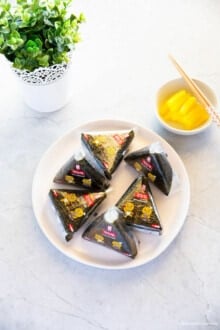Jjolmyeon (Jjol myun), an addictive Korean spicy chewy noodle recipe.
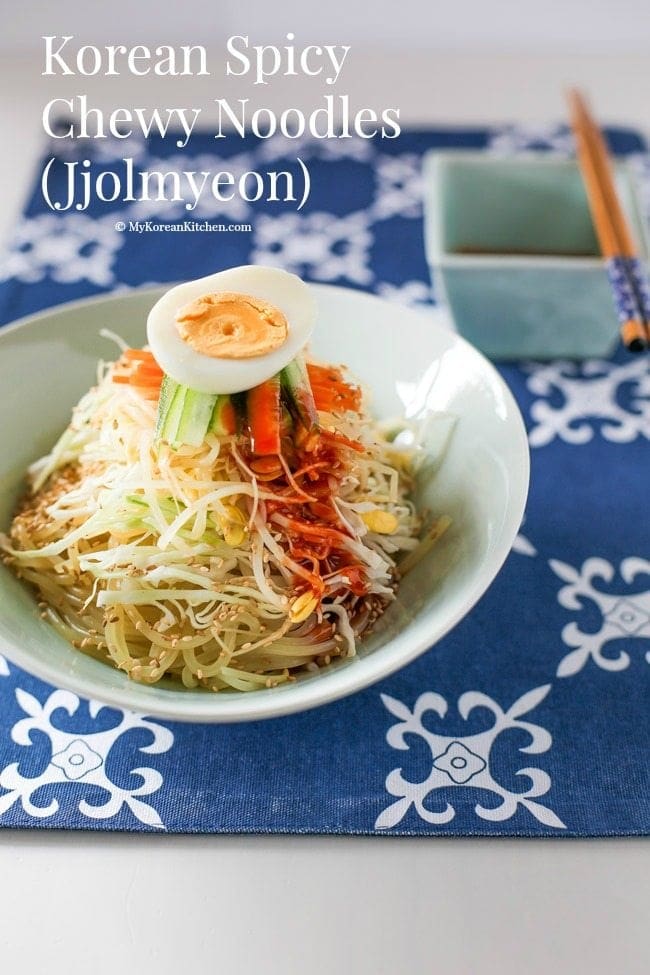
Today I’m sharing my teenagehood favourite dish – Jjolmyeon (쫄면, Korean spicy chewy noodles).
It is commonly available at a Korean snack restaurant (Bunsikjeom, 분식점), where it also sells, Korean rice rolls (Kimbap, 김밥), Korean spicy rice cakes (Tteokbokki, 떡볶이), Udon noodles and various other inexpensive Korean snack food.
Probably because of this reason, it’s such a popular spot for a teenager to hang around after school.
During summer, every time I went to Bunshikjeom in my school days in Korea, I ordered Jjolmyeon. I don’t know what it is, but to me this dish has such a captivating magic around it.
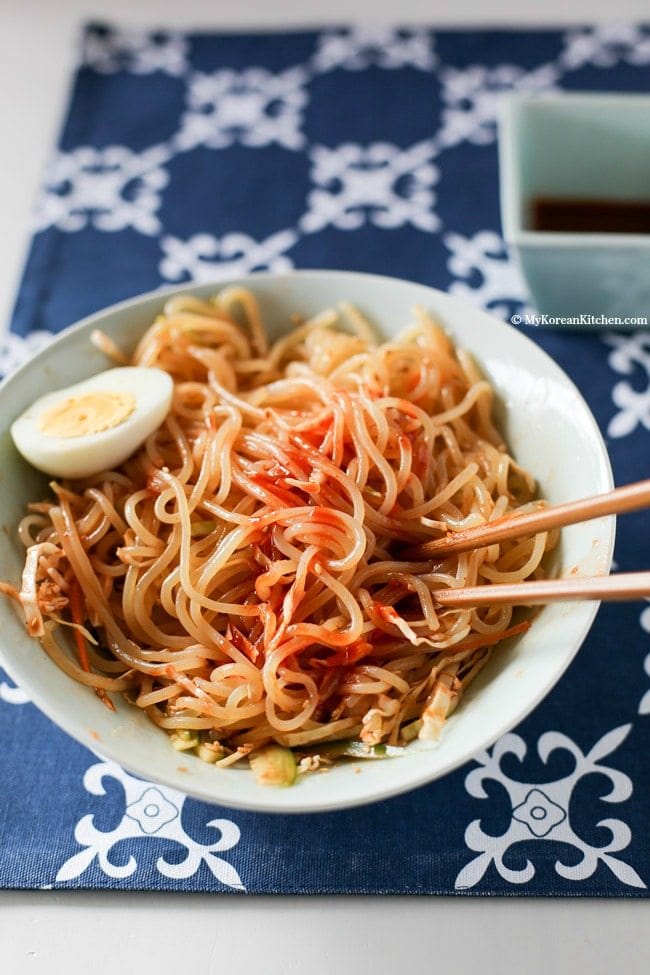
The highlight of Jjolmyeon is of course, the chewy bouncy textured noodles. The word, Jjol originated from Jjolgit-Jjolgit (쫄깃쫄깃), which describes the bouncy chewy nature of noodles.
Another highlight of Jjolmyeon is my favourite – sweet, tangy and spicy sauce. These chewy noodles with sweet, tangy and spicy sauce is just a perfect combination in my mind.
They are addictive. They will hook you on and you will think about it every now and then, just like me. 🙂
To make Jjolmyeon, you prepare each ingredient separately but assemble them together in a bowl, just like you would for Bibimbap. So you can class Jjolmyeon as a type of Bibim Guksu (비빔국수 – Mixed noodles). I hope you get to try this soon!
Ingredients for Jjolmyeon, 2 servings
- 70g (2.5 ounces) Cabbage – only use the white soft part, rinsed and thinly sliced
- 70g (2.5 ounces) Lebanese cucumber – rinsed, seed removed and julienned
- 20g (0.7 ounces) Carrots – rinsed, skin peeled and julienned
- 100g (3.5 ounces) Soybean sprouts – rinsed and bad beans removed
- 400g (0.9 pounds) Korean chewy noodles (Jjolmyeon)
- 2 tsp roasted sesame seeds
- 1 hard boiled egg – peel the shell and cut into half
- Sweet, tangy and spicy sauce – Mix these in a bowl. This sauce is possibly enough for 3 servings, depending on how ‘hot’ you want these noodles to be. This sauce is modified from my original sweet, tangy and spicy Korean dipping sauce.
- 4 Tbsp Gochujang (Korean chili paste)
- 2 Tbsp Rice vinegar
- 2 Tbsp Lemon juice – squeezed out from lemon
- 2 Tbsp Raw sugar
- 2 Tbsp Honey
- 1/2 tsp Minced garlic
*1 Tbsp = 15ml
**If you want to know more about Korean cooking ingredients, check my “30 essential Korean cooking ingredients list!”
How to Make Jjolmyeon
1. Prepare the ingredients (vegetables and sauce) as listed above.
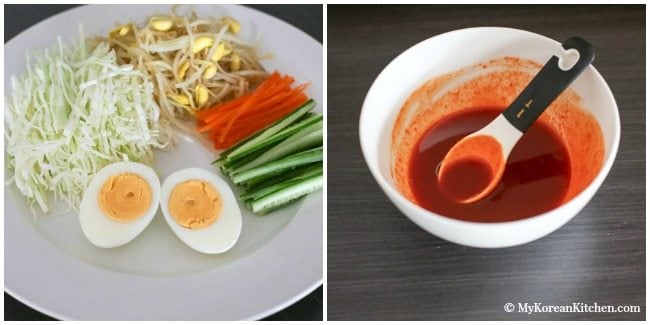
-For soy bean sprouts, boil some water (enough to cover the the soy bean sprouts) and when the water starts rolling boiling, plunge the soy bean sprouts and close the lid. Cook it for 45 seconds to 1 minute. Drain the water out and cool the soy bean sprouts in running cold water. Drain any excess water for 1 to 2 mins.
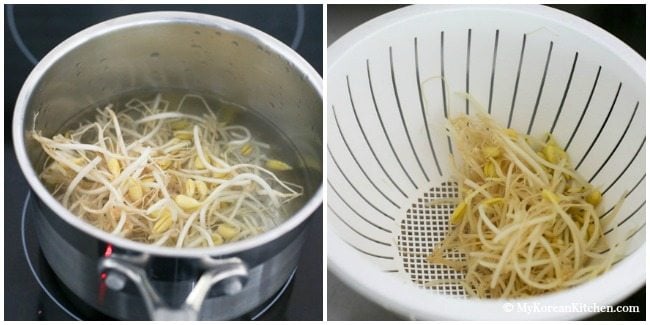
-For the jjolmyeon (chewy noodles) – to be prepared last, boil some water (about double the quantity of your noodles) with the lid closed. While the water is boiling, separate the individual (frozen) noodles with your hands under cold running water.
Once the water is rolling boiling, add the separated noodles into the pot and cook them for 3 to 4 mins without the lid on. (I cooked mine for 3 mins but follow the manufacturer’s instructions.) During this time, swirl around the noodles with some tongs. (Don’t overcook the noodles as overcooked noodles aren’t as bouncy as they should.)
Once the noodles are cooked, drain the water and cool the noodles down with running cold water. Rinse the noodles a couple of times with your hands to remove any excess starch.
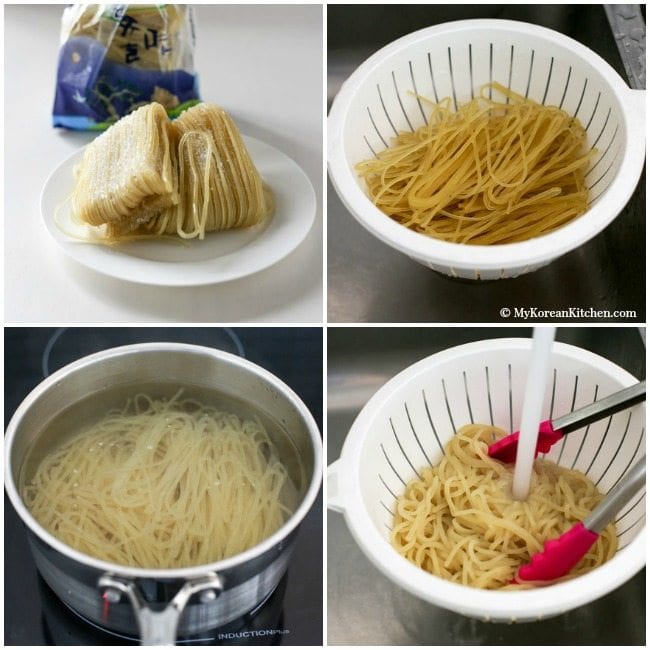
2. Assemble all the prepared ingredients.
This is how I did mine. (Place the noodles in the bottom of the bowl. Stack the vegetables on top of each other (in the order of cabbage, soy bean sprouts, carrots and cucumber). Sprinkle the sesame seeds (1 tsp per serving) around the vegetables and noodles. Place the egg on top of the cucumber and pour the sauce in one side (I used 4 Tbsp of the sauce per serving)).
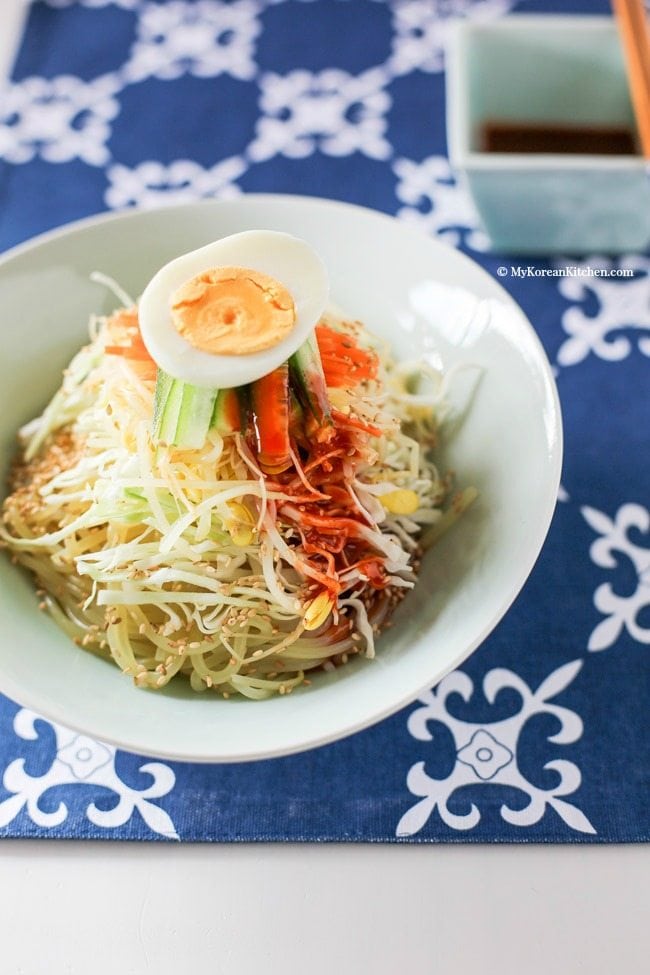
Dig in. (Mix the sauce evenly with the rest of the ingredients in the bowl).
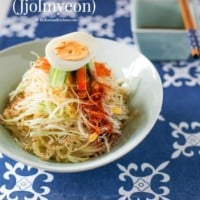
Jjolmyeon (Korean Spicy Chewy Noodles)
Ingredients
- 70 g Cabbage (2.5 ounces), only use the white soft part, rinsed and thinly sliced
- 70 g Lebanese cucumber (2.5 ounces), rinsed, seed removed and julienned
- 20 g Carrots (0.7 ounces), rinsed, skin peeled and julienned
- 100 g Soybean sprouts (3.5 ounces), rinsed and bad beans removed
- 400 g Jjolmyeon (0.9 pounds), Korean chewy noodles
- 2 tsp toasted sesame seeds
- 1 hard boiled egg , peel the shell and cut into half
Sweet, tangy and spicy sauce - Mix these in a bowl.
- 4 Tbsp Gochujang (Korean chili paste)
- 2 Tbsp Rice vinegar
- 2 Tbsp Lemon juice – squeezed out from lemon
- 2 Tbsp Raw sugar
- 2 Tbsp Honey
- 1/2 tsp Minced garlic
Instructions
- Prepare the ingredients (vegetables and sauce) as listed above.-For soy bean sprouts, boil some water (enough to cover the the soy bean sprouts) and when the water starts rolling boiling, plunge the soy bean sprouts and close the lid. Cook it for 45 seconds to 1 minute. Drain the water out and cool the soy bean sprouts in running cold water. Drain any excess water for 1 to 2 mins.-For the jjolmyeon (chewy noodles) - to be prepared last, boil some water (about double the quantity of your noodles) with the lid closed. While the water is boiling, separate the individual (frozen) noodles with your hands under cold running water.Once the water is rolling boiling, add the separated noodles into the pot and cook them for 3 to 4 mins without the lid on. (I cooked mine for 3 mins but follow the manufacturer’s instructions.) During this time, swirl around the noodles with some tongs. (Don’t overcook the noodles as overcooked noodles aren’t as bouncy as they should.)Once the noodles are cooked, drain the water and cool the noodles down with running cold water. Rinse the noodles a couple of times with your hands to remove any excess starch.
- Assemble all the prepared ingredients.-This is how I did mine. (Place the noodles in the bottom of the bowl. Stack the vegetables on top of each other (in the order of cabbage, soy bean sprouts, carrots and cucumber). Sprinkle the sesame seeds (1 tsp per serving) around the vegetables and noodles. Place the egg on top of the cucumber and pour the sauce in one side (I used 4 Tbsp of the sauce per serving).-Dig in. (Mix the sauce evenly with the rest of the ingredients in the bowl)).
Notes
Nutrition Info (per serving)
The nutrition information shown is an estimate provided by an online nutrition calculator. It should not be considered a substitute for a professional nutritionist’s advice.
